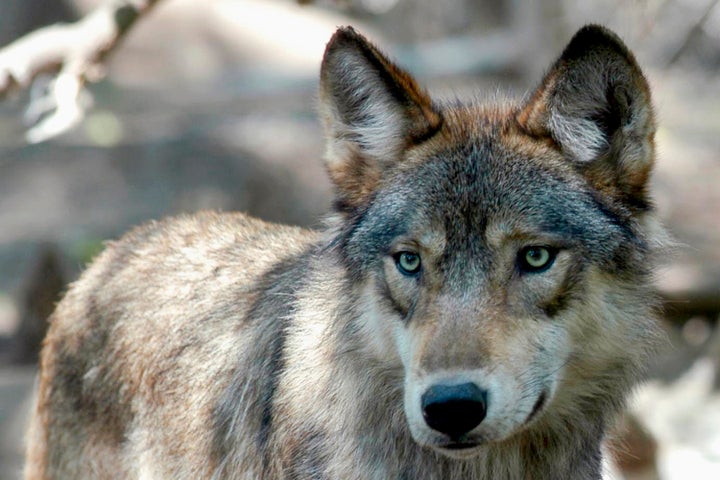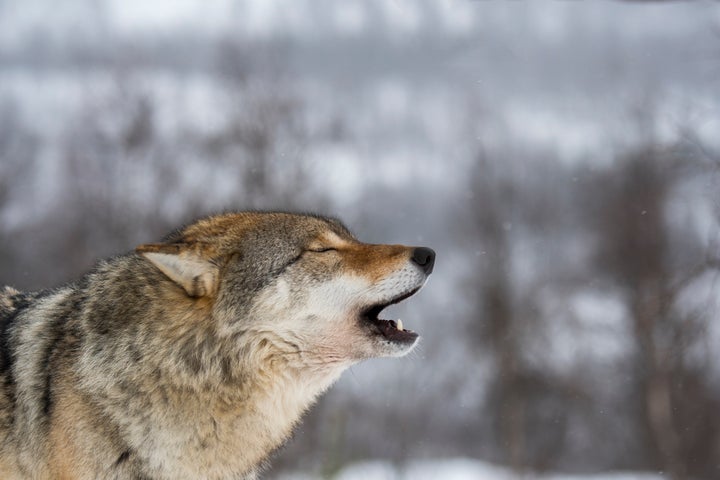DENVER ― My, Colorado, what adventurous ballot measures you have!
The better to reintroduce wolves with, my dear.
Colorado voters are expected to pass Proposition 114, directing the Colorado Parks and Wildlife Commission (CPW) to develop a plan for reintroducing gray wolves in the state.
While the Associated Press hasn’t officially called the race, which has hovered in too-close-to-call territory for days, CPW said Thursday that it expects the measure to pass, as the margin of votes in favor of it ticked past 30,000. The proposition’s opponents also conceded Thursday.
The measure directs CPW to lay out and implement a program by the end of 2023, with the first wolves set for release in the mountainous western half of the state. The Parks and Wildlife Commission will also take on the responsibility of fairly compensating ranchers for any livestock lost to predation.
The passage of Proposition 114 marks the first time in U.S. history that voters ― not land managers ― have directed the reintroduction of a species.
Humans largely eradicated Canis lupus from the western U.S. in the 1930s via a combination of shooting, trapping and poisoning. Colorado’s last native gray wolf was killed sometime between 1943 and 1945 in a remote southern corner of the rugged San Juan Mountains.
In 2009, a female wolf known as 341F made headlines after traveling more than 1,000 circuitous miles across the Mountain West region, tracing a route from southern Montana through Wyoming and northeast Utah before finally reaching Colorado’s White River National Forest.
The wolf died suddenly that March. Given her body’s proximity to a road, 341F was initially believed to have been hit by a car. Subsequent tests showed she’d actually been poisoned by Compound 1080, a cousin of sodium cyanide that’s illegal in Colorado.
Unlike in Wyoming and Montana, where self-sustaining gray wolf populations led to a relaxing of the species’ protected status, Canis lupus was a federally protected endangered species in Colorado at the time and therefore illegal to kill. (The Trump administration delisted the gray wolf from Endangered Species Act protections at the end of October.)
No suspects were ever identified in the death of 341F.
Like her, a handful of other confirmed lone wolves have wandered into Colorado via Wyoming over the years (in 2004, 2007, 2009, 2015 and 2019), but without any means to reproduce they’re doomed to wander and die alone, a fate often expedited by a speeding vehicle.
Proposition 114’s opponents would have liked to keep it that way.
Writing for western Colorado’s Montrose Daily Press, one opponent compared the reintroduction of gray wolves to putting “50 serial killers on the loose in our mountains” and warned of the potential threat to humans, livestock and domestic pets.
“This is a decision that belongs to the folks affected, not those of Denver, Boulder, Aurora, and Golden,” the writer argued, highlighting the state’s growing rural-urban divide.
While fatal encounters with wolves in North America are exceedingly rare, the proposition’s opponents noted that run-ins with humans are inevitable.
Richard Connell, a director at the Colorado Farm Bureau, which opposed the measure, argued that Colorado’s demographics are especially problematic compared to those of other states where wolves have already been reintroduced. Colorado has less than one-third of the combined land area of Wyoming, Idaho and Montana, yet more than double the human population.
“Knowing the kind of people we have in Colorado who have fed bears, and fed other wildlife on their back porches, [wolves] will start learning the habits of people, and start wandering into backyards,” Connell told the Aspen Times.
“Those wolves will become habituated to our way of life,” he said. “When they do, they watch us, they learn from us. Eventually, they will become bold enough to attack us.”
Commissioners in 39 counties, most of them rural, passed nonbinding resolutions opposing the measure. That list includes Moffat County in northwestern Colorado, where a pack of six wolves was spotted in March, having entered from Wyoming.
In 2016, the Parks and Wildlife Commission adopted what effectively amounted to a “live and let live” policy regarding wolves in the state. Should they migrate here naturally, the agency agreed to leave them be, but it opposed the intentional release of the animals, noting their potential to harm Colorado’s livestock industry and big game population, both of which are significant contributors to the state economy.
The Rocky Mountain Elk Foundation, which opposed the measure, criticized it as “ballot-box biology.”
“Using the ballot box to circumvent professional wildlife managers and create wildlife management policy is reckless. On top of that, now more than ever, it’s fiscally irresponsible,” said the foundation’s president, Kyle Weaver, referring to the state’s multibillion-dollar budget shortfall thanks to the COVID-19 pandemic.

Proponents of reintroducing the gray wolf say there was no other way.
Colorado’s constitution explicitly prohibits federal authorities like the U.S. Fish and Wildlife Service from reintroducing endangered species. Instead, that right is reserved for the state legislature or voters via ballot measure. Previous attempts to pass legislation, including one in January, failed to gain traction.
Proponents also say that the science backs them up, with advocates highlighting ecological successes in Yellowstone National Park after wolves were returned there as proof that Colorado should follow suit. Wolves are credited with triggering a “trophic cascade” in the park after their reintroduction in 1995, improving the health of an entire ecosystem via the addition of this apex predator.
“The wolf’s primary ecological impact has to do with their relationship to their prey,” said John Murtaugh, the Rockies and Plains representative for Defenders of Wildlife, an organization that has long advocated for reintroducing wolves.
“In the absence of predators, animals like elk and deer spend more time browsing in a specific region,” he told HuffPost. “This can lead to over-browsing, which can impact the ability for plants to regenerate and damage the soil.”
Rocky Mountain National Park, home to an increasingly non-migratory elk herd, has had to contend with similar damage. Land managers there have responded by culling animals when necessary and installing fencing to protect damaged habitat.
“With wolves on the landscape, elk and deer need to stay on the move,” said Murtaugh. “This movement allows for a more natural and even distribution of grazing patterns, giving plants time to generate and grow. Vegetation like aspen and willow shoots are then more likely to persist into maturity, providing habitat for animals like songbirds and beaver.”
“Over time, these effects can ripple out and impact a wide variety of species. This wide-reaching effect is known as a trophic cascade and, in the case of wolves, can represent a return to a more natural balance,” he continued.

Colorado wildlife experts hope that wolves might also reduce the spread of chronic wasting disease (CWD), an elk-borne prion similar to mad cow disease that first cropped up in the 1980s. As elk herd populations soared to record highs in the 1990s, the disease spread right along with them.
CWD has now been detected in more than half of Colorado’s deer herds and around 40% of the state’s elk herds. According to Diana Tomback, a professor at the University of Colorado Denver with expertise in evolutionary ecology, there’s reason to hope that wolves would help contain it.
“Wolves target weak prey and detect diseased animals, and many experts think that wolves could limit the spread of this CWD,” Tomback told a university publication. “The increasing incidence of this disease may be related to wolf extirpation.”
As for the threat that wolves pose to cattle and elk, Tomback is unconcerned.
“In the northern Rockies states ― where there are now about 2,000 wolves and 1.6 million cattle ― wolves prey on less than 0.01% of cattle annually,” she said. “In these states, cattle outnumber elk about 4 to 1, but wolves prefer elk as prey.”
If the wolves end up reducing CWD, hunters stand to benefit from a healthier elk population, too. In addition, there isn’t as clear a link between wolf predation and elk population as one might think. “Wolf predation by itself does not initiate declines in prey populations,” Montana’s Department of Fish, Wildlife and Parks found, “but it can exacerbate them or lengthen periods of prey population rebounds.”
Studies of elk and wolf interaction in Montana and Yellowstone found that factors like drought, habitat, other large predators and human hunting all play a large role in elk populations.
Soon, the wolf can play its part in Colorado’s ecological balance, too.
